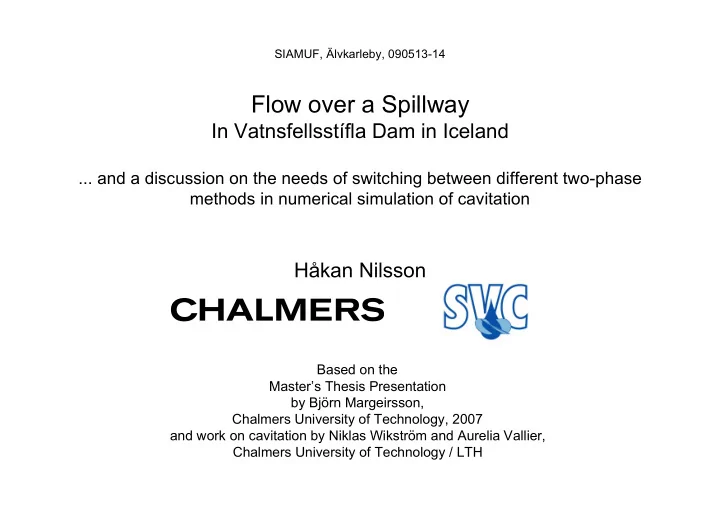

SIAMUF, Älvkarleby, 090513-14 Flow over a Spillway In Vatnsfellsstífla Dam in Iceland ... and a discussion on the needs of switching between different two-phase methods in numerical simulation of cavitation Håkan Nilsson Based on the Master’s Thesis Presentation by Björn Margeirsson, Chalmers University of Technology, 2007 and work on cavitation by Niklas Wikström and Aurelia Vallier, Chalmers University of Technology / LTH
Vatnsfellsvirkjun hydraulic power plant from above
The spillway at Vatnsfell – from below
The spillway at Vatnsfell – the crest
The splitter wall and cover from above
The chute cover from below
The spillway and the stilling basin
The spillway – characteristics • Function: cope with accidental flooding • Height above stilling basin bottom: 27.5 m • Lenght of spillway crest: 50 m • Equipped with a splitter wall and cover to prevent overtopping of the chute sidewalls • The velocity of the water is above 20 m/s (=72 km/hour!) where it flows into the stilling basin
The stilling basin – characteristics • Function: Decrease flow velocity in order to decrease risk for erosion in the river valley downstream the basin • Equipped with 28 energy dissipating baffles (height from 1.5 to 2.0 m) • Length ca. 33 m and the width increasing from 22 m in the upstream part to 33 m in the downstream part, depth ca. 7 m • Downstream the stilling basin is a 35 m long rock rip-rap made of rocks with diameter of 0.4 – 1.2 m
Layout chute, bottom outlet and stilling basin
1:30 model at VRD, 1999 Neither splitter wall nor chute cover...
1:30 model at VRD,1999 Both splitter wall and chute cover...
Computational domain
Computational mesh: 497 664 cells, generated in Gambit! Fluent run on a laptop, in 2007!
Mesh refinement in the region of the water surface, here at the crest • Left: designed for flow discharge of 50 m 3 /s • Right: designed for flow discharge of 350 m 3 /s
Hybrid mesh of the basin bottom and the downstream end of the spillway chute
Hybrid mesh of the basin and the downstream end of the spillway chute
S implified rock rip-rap downstream the basin
Velocity contours in the spillway and the stilling basin.
Volume fraction of water in the basin (longitudinal profile) In the wake of the splitter wall, and in the baffle region, the VOF method is not appropriate, and there is a need for a switch to another method
Main results - summary • Detailed comparisons can be found in the report Note that the meshes are far from sufficiently fine • Good agreement is reached between the experiments and CFD calculations for the following aspects: – head vs. discharge capacity (Q=CBH 3/2 ) – pressure in the spillway chute – flow velocity above the basin end sill • Worse agreement is reached for: – pressure on baffles in the upstream end of the basin – water depth along chute sidewalls and in the left upstream corner of the basin – pressure on the basin end sill
VOF for cavitation inception and break-up on a hydrofoil There is a need for coupling between VOF and another method as the sheet breaks off
LPT of cavitation nuclei There is a need for coupling between a method for transport of cavitation nuclei, and the VOF method
Thank you! Acknowledgements to: Björn Margeirsson, Niklas Wikström, and Aurelia Vallier
Recommend
More recommend